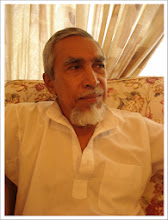1. As a small boy I was very fond of listening
to stories. One of my uncles used to tell local folk tales which I enjoyed very
much. At times there were also nonsensical ghost stories and scary tales. One
particular tale typically whispered by the womenfolk was absolutely terrifying.
2. It was about an eerie stranger the likes of
a grass cutter who carried a sickle and a gunny sack except that he wasn’t
looking for any grass to cut. Supposedly he went stalking for solitary kids
wandering in vast paddy fields or along deserted lanes. It was rumoured that he
would sever a child’s head with his sickle and carry it away in his gunny sack.
3. The rumours surfaced at the time when a new
bridge was being built in town and word had it that the severed head would be
offered as a sacrifice so as to protect the bridge from falling down. Indeed,
it was scary and children were told to play it safe in order to avoid going
missing. But as I grew older I thought it was just another cautionary tale.
4. That
was around the mid-50s and I had long forgotten about it until recently when I
chanced upon an article on the internet about the discovery of a bronze oil
lamp buried in the foundations of a Roman building. Archaeologists believe it
was deposited as a ‘foundation deposit’ about 1,900 years ago.
5. That
was the first time I came across the term ‘foundation deposit.’ According to
one definition “Foundation deposits are
the archaeological remains of the ritual burial of materials under
the foundations of buildings.” (From Wikipedia, the free encyclopaedia)
6. As regards the content of the
article, what interests me
most is the exemplification of foundation deposits which include material
objects such as divine figurines, lamps and coins. For instance, several years
back archaeologists discovered a foundation
deposit which was a cache of gold and silver divine figurines dated to 3,600 years ago. It was found inside a
clay pot buried within the foundations of a building.
7. That said,
foundation deposits may not be material objects alone. A discovery made over a century ago revealed that a human
being was buried in the foundations probably for the purpose of serving as a
guardian spirit.
8. According
to the report, in some cultures people would bury their dead
under the floor inside their home believing that the spirits of the dead would
protect them and the household; hence the suggestion that the practice of home
burial in ancient times was antecedent to the ritual burial of
materials under the floors of buildings or foundations.
9. One of the authors of the discovery pointed out that it’s rather misleading to
think of foundation deposits as artefacts of ancient superstition. He used to
work in construction in the early 80s and told of workers
throwing money inside when they built the
foundations.
10. He said the practice was
related to popular belief. Since ancient times foundation deposits was accepted
in construction to bring luck or as symbolic protection of the building or even
to cast fear and awe on attackers.
11. The practice is considered a common cultural norm in the ancient world. The archaeologists
suggest ritual offerings buried during construction were intended to ensure the
safety of building and its occupants.
12. Obviously the article reminded me of the
scary tale that I’ve mentioned earlier, prompting me to wonder if it was really
just another cautionary tale. Was the sacrifice bit actually made up to scare
children or had it got something to do with the construction of the bridge?
13. At the time Malaya (or Tanah Melayu)
was still under British rule. The key players involved in the construction of
the bridge were people from different cultural backgrounds and beliefs. They
comprised of British officials and professionals from the immigrant population.
That said, there is room for popular belief too even among the cosmopolitans.
________
In passing
 |
| "You need the shovel? What for?" |











No comments:
Post a Comment